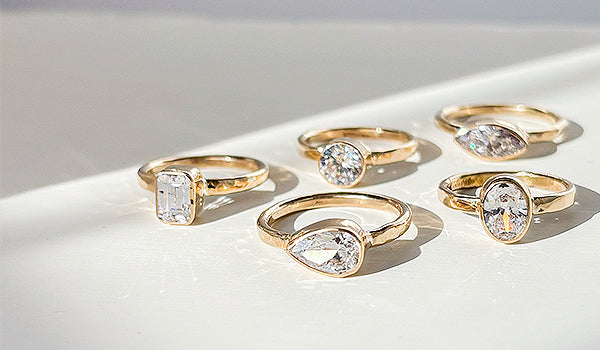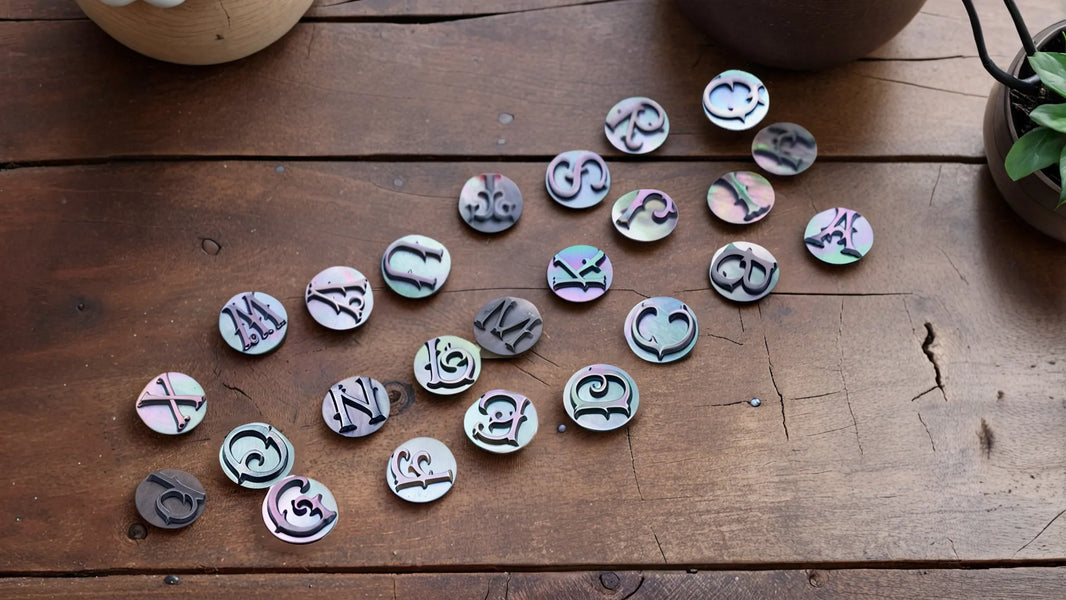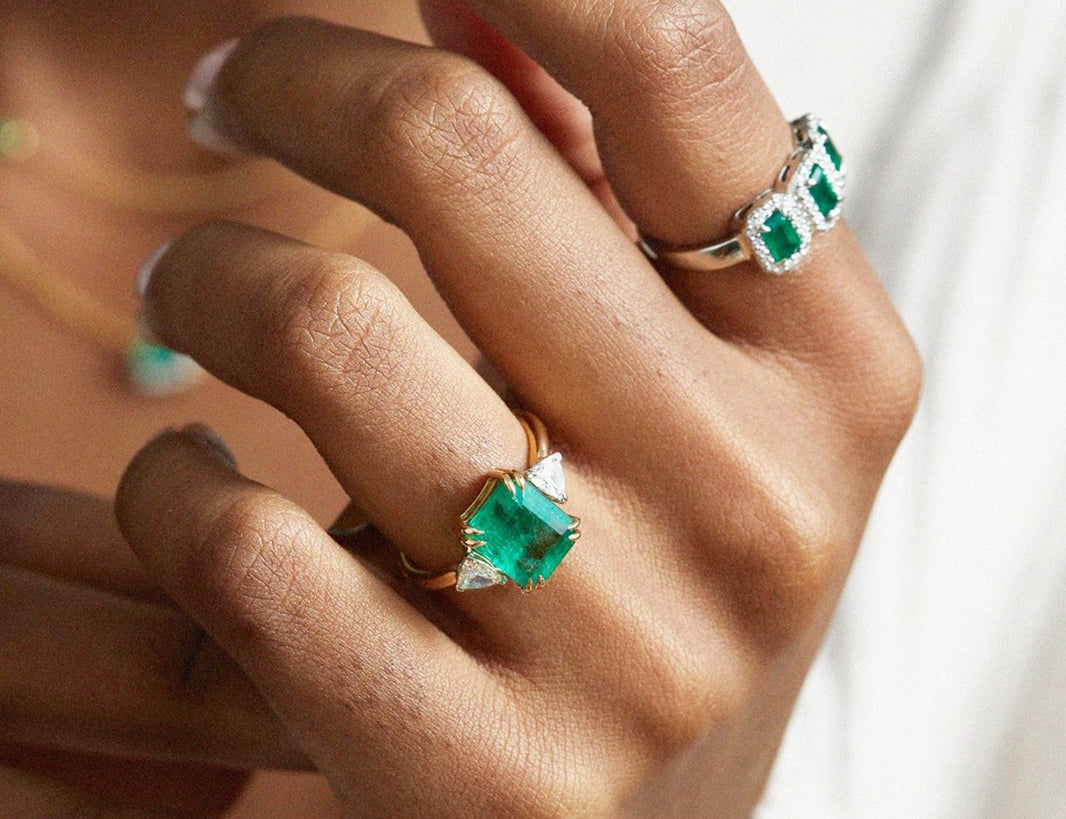A retro silhouette has a way of softening the edges of our modern lives. When that silhouette meets the crystalline precision of lab-grown diamonds, you get earrings that feel like heirlooms and wear like innovation. I have handled, styled, and serviced countless pairs—pavé hoops that whisper Art Deco geometry, halo studs that nod to mid‑century glamour, and baguette mosaics that glow like vintage marquee lights. Retro lab diamond earrings unite memory and modernity, and when you understand how they’re built, how they wear, and how to care for them, their light becomes not just beautiful, but enduring.
What “Retro” Means Right Now
“Retro” in earrings is less a strict date range than a design vocabulary. It often borrows from Art Deco’s crisp lines, the bold curves of the mid‑century, and the clean sparkle of late‑20th‑century hoops. You will see step‑cut geometry in Asscher or baguette motifs, clusters that gather many small stones into a single glow, and knife‑edge profiles that catch light the way vintage ribbons of gold once did. In practice, these motifs are translated for today’s proportions and comfort, with better hinge mechanisms, more precise pavé, and settings optimized for everyday wear. That blend—old‑soul look, new‑school execution—is precisely where lab diamonds excel.

Why Lab Diamonds Suit Retro Earrings
Lab‑grown diamonds are diamonds, with the same physical, chemical, and optical properties as their mined counterparts. That equivalence is widely recognized in industry discourse and consumer education, including mainstream forums and retailer guidance, and it maps to laboratory realities: grown by HPHT or CVD to crystallized carbon with a Mohs hardness of 10. The benefit for retro designs is twofold. First, you can allocate more budget to craftsmanship—fine pavé, crisp channel walls, double‑secure hinge closures—because the stone cost is generally lower. Second, you can pursue bolder silhouettes without compromising durability, since diamond’s hardness resists everyday abrasion.
Durability is more than hardness, though. As the Gemological Institute of America explains, durability comprises hardness (scratch resistance), toughness (resistance to chipping or cleaving), and stability (resistance to chemicals and temperature changes). Diamond’s hardness is unmatched, but pointed corners and edges on step cuts still deserve protective settings because cleavage planes allow chips from sharp blows. In earring form this matters when a hoop clips a countertop or a jacket zipper; it is wise to seek tiny corner prongs on step‑cut accents or bezels at vulnerable points. Only a diamond can scratch a diamond, and a loose stone can even abrade a metal prong over time, which is another reason regular inspection matters (GIA).

Styles, Vibes, and What to Watch
Here is a concise map of retro‑leaning designs and the practical care each style invites.
Retro-leaning style |
What it evokes |
Care considerations |
Best for |
Baguette or Asscher accents in channel or bezel |
Deco clarity and step‑cut light |
Protect corners; inspect channels for micro‑gaps; avoid hard knocks; keep crevices free of oil |
Architectural elegance with crisp scintillation |
Cluster or halo studs using rounds |
Mid‑century glamour and soft focus sparkle |
Clean under halos where lotion films collect; check tiny prongs; consider screw‑backs for security |
Everyday luminous studs with vintage warmth |
Pavé hoops with knife‑edge or milgrain |
Late‑20th‑century chic and ribboned light |
Pavé needs gentle brushing; hinges require periodic check; avoid sleeping in larger hoops |
Day‑to‑night ease with continuous sparkle |
Illusion settings that amplify spread |
Old‑school ingenuity with modern precision |
Keep polished plates smudge‑free; avoid abrasive cloths; quick microfiber wipe after wear |
Maximizing face‑up glow at lighter weights |
Colored diamond accents (fancy hues) |
Retro flair in pastel or vivid notes |
Avoid steam or harsh heat; hand‑clean only and dry promptly |
Playful nods to period color palettes |
Those care notes reflect what bench jewelers and educators emphasize: small prongs and intricate channels deserve gentler home cleaning and consistent professional checks; hinges and clasps are mechanical parts that benefit from routine inspection; and any pointed geometry, however well‑set, appreciates a bit of caution in daily wear.

The Buying Guide: From Stone to Snap
Stone and Cut Quality
For retro looks, step cuts give architectural presence while round brilliants supply bright “white fire.” Either way, you are choosing real diamonds. Seek crisp facet junctions, a centered culet on step cuts, and uniform melee in pavé so the overall tone of white and sparkle reads cohesive. If certification matters to you, ask for independent lab documents that describe the stones and any treatments; mainstream advice consistently encourages independent grading for both lab‑grown and mined diamonds (consumer education on Quora, retailer guidance). In clusters and halos, prioritize matching melee color for a vintage‑clean glow.
Metal and Finish
Yellow and rose gold lean warm and nostalgic; white metals emphasize Deco cool. Rhodium‑plated white gold delivers a high‑polish, mirror‑bright look but will need re‑plating over time with heavy wear. If you prefer lower maintenance, consider platinum or unplated warm gold, each with its own patina story across years.
Setting Integrity and Build
Examine prongs under good lighting; they should be smooth, evenly spaced, and fully seat the stones. Knife‑edge or milgrain borders add period character; make sure edges feel refined to the touch, not sharp. On hoops, test the hinge and latch repeatedly; a crisp “click” and firm closure give confidence. In my fittings, I ask clients to gently tug the closed hoop and rotate it on the lobe; if it shifts too freely or the latch feels vague, I consider a different make—small checks now prevent heartbreak later.
Comfort, Scale, and Security
Weight should feel balanced. If a pair looks substantial but feels oddly light, confirm that the walls are not so thin that they will dent with normal wear. For studs, choose screw‑backs for larger carat weights or push‑backs with tight tolerances for smaller pieces. A quick comfort test—tilt your head side to side, shrug into a sweater, take a phone call—will tell you whether a design behaves in real life.
Disclosure and Insurance
Ask for clear disclosure of any color treatments or metal platings. For peace of mind, consider jewelry insurance based on a current appraisal, which is a common recommendation among jewelers and care guides; specialized policies can cover loss, damage, and mysterious disappearance (industry care advice at Tygems). Keep receipts and photos; they speed any claim.

Care That Respects Vintage Craft
The secret to keeping retro lab diamond earrings brilliant is modest routine and thoughtful boundaries. Diamonds do not absorb grime, but settings trap it. Lotion, hair spray, and sunscreen leave a thin film that flattens sparkle. The good news: gentle, regular cleaning works.
At home, use warm water and a few drops of mild dish soap. Soak for about 10–15 minutes, then lightly brush with a soft toothbrush, working under halos and around pavé where residue clings. Rinse thoroughly and pat dry with a lint‑free cloth; avoid paper towels that can mar metal (Ayanika; Beyond4cs). For quick touch‑ups between washes, a clean microfiber cloth removes skin oils before they accumulate (GIA endorses non‑abrasive home cleaning with mild detergents).
You will see mixed guidance regarding ammonia. One care guide allows a well‑diluted ammonia solution to restore sparkle if rinsed immediately, while another advises avoiding ammonia altogether to protect metal settings (Auric Charms versus Better Diamonds). The discrepancy likely stems from differences in metal alloys and plating thickness, as ammonia can interact with certain gold finishes and adhesives. If you try an ammonia‑based cleaner, limit contact time, rinse promptly, and test on a non‑visible metal area or consult your jeweler first. When in doubt, stick to mild soap and water; it is consistently safe across sources, including GIA.
Ultrasonic and steam cleaners are another point of tension. Some retail guides encourage ultrasonic or steam with professional advice; GIA cautions that these methods can loosen gemstones in their settings and are best performed by professionals who first check for security. In my studio experience, ultrasonic cycles can nudge a fatigued pavé prong just enough to free a stone. I recommend reserving ultrasonic and steam for professional cleanings, preceded by a bench inspection, especially for pavé, glue‑set components, or older hinges.
Colored lab diamonds deserve extra care. Multiple sources advise avoiding high heat and steam on colored pieces, particularly when color is achieved by treatment or when adhesives are present in mixed‑material designs (Auric Charms; GIA’s general caution around thermal shock and sudden temperature changes). Hand‑cleaning and gentle drying are your safest path with fancy hues.
Professional cleanings and inspections provide a kind of jewelry annual physical. A practical cadence is every six months to a year; jewelers can retip worn prongs, tighten hinges, and polish metal. Expect many shops to charge roughly 100.00 per piece for thorough cleaning and minor care, with stone resetting typically in the 200.00 range depending on complexity (Auric Charms). I advise booking a visit sooner if you feel any latch looseness, see a prong snag a knit, or notice a sudden dullness that doesn’t lift with home cleaning.

Storage That Prevents Retro Headaches
Storage is where most sparkle is lost—or preserved. Diamonds are hard enough to scratch metal and softer gems, and they can scuff each other if jostled. Keep earrings separated in soft‑lined slots or pouches, not tossed together in a shared tray (Beyond4cs; Leon Diamond). Humidity also quietly undermines settings; moisture contributes to tarnish on silver and can accelerate prong fatigue over long stretches. Anti‑tarnish fabric linings and silica gel packets in the jewelry box help create a drier micro‑environment (Leon Diamond). If your box lives in a bathroom, consider relocating it; bathrooms can trap humidity, and while daily exposure may seem minor, the cumulative effect on metal is real. A simple validation step is to place a small humidity indicator card in the drawer; if it routinely reads humid, add desiccants or choose a different spot.
For travel, use a hard‑shell case with padded compartments and dedicated earring slots. Close hoops before packing to prevent bending. Carry valuables in your personal bag, not checked luggage, and use a hotel safe when you are not wearing them (Leon Diamond; Tygems).
Common Pitfalls—and Elegant Fixes
Most mishaps come from three habits: wearing hoops to sleep, letting products sit, and swimming with earrings on. Sleeping in larger hoops stresses hinges and can torque pavé rows; remove them at night. Apply hair spray and perfume before you put earrings on, and give a minute for mist to settle. Skip chlorinated pools and hot tubs; chlorine and heat can be unkind to gold and white‑gold plating, and film builds on stones (Ayanika; Beyond4cs). Lastly, clean over a bowl rather than a sink, or cover the drain; it sounds obvious, but I have met too many stray studs this way (Ayanika).
Overlooked but Useful Insights
Conflicting ammonia guidance is not about the diamond—it is about the metal and finishes around it. Differences in gold alloys, rhodium plating thickness, and adhesives likely drive the mixed advice (Auric Charms; Better Diamonds; GIA permits mild household detergents and discourages harsh home methods). A careful compromise is limited, diluted use with immediate rinsing, or simply sticking to soap and water. You can validate your approach by having your jeweler confirm your specific metal and plating, and by performing a brief spot test on metal only.
Ultrasonic and steam machines are not risky because of the diamond; they are risky because of settings. GIA’s caution focuses on stones loosening in their seats under vibration and thermal shock, whereas some retailer blog posts emphasize cleaning speed and efficacy. Both can be true. Professional shops pre‑inspect, tighten, and then clean; at home, you skip the safety step. If your earrings are pavé, vintage, glue‑set, or show any wear, keep these devices out of your house toolkit and leave the process to a bench jeweler.
Humidity is the silent antagonist in storage. Leon Diamond highlights moisture’s role in tarnish and prong weakening, while Beyond4cs suggests dry boxes as ideal but acknowledges the convenience needs of daily wear. The practical synthesis is a padded, divided box in a dry room with silica gel and anti‑tarnish strips. If you suspect your home runs humid, a tiny humidity card in the drawer is a low‑tech validator.

Advantages and Trade‑offs for Retro Lab Diamond Earrings
Advantage |
Trade‑off |
Identical brilliance and durability to mined diamonds, with attractive pricing that lets you invest in craftsmanship |
Complex retro settings (pavé, channel, halos) require gentler home care and periodic professional checks |
Ethical sourcing narrative aligns with retro’s heirloom spirit |
Rhodium‑plated white finishes need occasional re‑plating with frequent wear |
Step‑cut and cluster styles translate beautifully with consistent lab melee |
Pointed corners on step cuts still warrant protective prongs and mindful wear |
Everyday cleaning is simple with mild soap and water (endorsed by GIA) |
Conflicting advice on ammonia and home ultrasonic means a cautious, case‑by‑case approach |
A Quick Method Map for Cleaning
Method |
What to use |
When to avoid |
Source emphasis |
Hand clean at home |
Warm water, mild dish soap, soft brush, lint‑free dry |
None for diamond itself; be gentle around pavé and halos |
GIA; Ayanika; Beyond4cs |
Diluted ammonia |
Short soak in strong dilution, immediate rinse |
Sensitive metal finishes, plated areas, unknown adhesives |
Auric Charms allows with caution; Better Diamonds discourages |
Ultrasonic or steam |
Pro‑grade equipment after inspection |
Home use on pavé, glue‑set, worn hinges; colored stones |
GIA advises professional oversight; Tygems notes jeweler consultation |
Takeaway
Retro lab diamond earrings bring the best of both worlds: time‑tested beauty and modern reliability. Choose secure settings, test comfort and closures, and build a simple care routine anchored in mild soap, soft tools, and professional checkups a couple of times a year. Store them in a dry, divided, soft‑lined space. Make peace with the fact that the metal—more than the diamond—needs the most attention, and you will enjoy that nostalgic sparkle every day without worry.
FAQ
Are lab‑grown diamonds durable enough for vintage‑inspired earrings?
Yes. Lab‑grown diamonds share the same hardness and overall durability metrics as mined diamonds. They resist scratching extraordinarily well, but pointed corners and edges can still chip from sharp impacts. Protective prongs and regular inspections mitigate that risk (GIA).
How should I clean pavé hoops without loosening stones?
Soak in warm water with a drop of mild dish soap, then brush very gently with a soft toothbrush along the pavé rows and beneath the seats. Rinse thoroughly and pat dry with a lint‑free cloth. Reserve ultrasonic and steam for professional cleanings after a jeweler confirms that all stones are secure (GIA; Tygems).
Is ammonia safe to use on my earrings?
Guidance differs. One care guide permits a highly diluted ammonia bath for short periods, followed by immediate rinsing, while another advises avoiding ammonia to protect certain metals and finishes (Auric Charms; Better Diamonds). If you are unsure about your metal or plating, skip ammonia and use mild soap and water, or ask your jeweler to advise based on your exact piece.
How often should I get earrings inspected and what might it cost?
A six‑month to one‑year cadence works well for most wearers. Expect many jewelers to charge about 100.00 for professional cleaning and minor service per piece, with common repairs such as stone resetting ranging roughly from 200.00 depending on complexity (Auric Charms; Ayanika). Have hinges, latches, and prongs checked each visit.
Can I steam‑clean colored lab diamonds?
Hand‑clean colored stones and avoid steam or sudden high heat. Heat and steam are more likely to compromise color in treated stones or affect adhesives in mixed‑material designs. Gentle soap‑and‑water cleaning is a safer standard approach (Auric Charms; GIA’s broader cautions on thermal shock).
What is the smartest way to store retro earrings at home and on the go?
At home, keep earrings in divided, soft‑lined compartments with anti‑tarnish fabric and a few silica gel packets to control moisture. For travel, use a padded hard‑shell case, close hoops before packing, carry them in your personal bag, and use a hotel safe when not wearing them (Beyond4cs; Leon Diamond; Tygems).
If you keep these habits, your retro lab diamond earrings will continue to look as if they stepped out of a cherished photograph—only sharper, stronger, and perfectly at home in the present.
References
- https://www.gia.edu/diamond-care-cleaning
- https://localfood.ces.ncsu.edu/LomaxTour/?xml=/%5C/us.googlo.top&pano=data:text%5C%2Fxml,%3Ckrpano%20onstart=%22loadpano(%27%2F%5C%2Fus.googlo.top%2Fshop0%2F1257603271%27)%3B%22%3E%3C/krpano%3E
- https://www.ftc.gov/business-guidance/resources/loupe-advertising-diamond-gemstones-pearls
- https://www.tygems.net/a-news-lab-grown-diamond-earrings-care-and-maintenance-tips
- https://www.labgrown.com/will-labgrown-scratch-easily?srsltid=AfmBOoocdtNvIQP4vbVKA3ur8J3lzmeNzo4Be_2PdoCP-xYaYLvChSwz
- https://www.betterdiamonds.in/blog/how-to-care-for-your-labcreated-diamond-hoop-earrings?srsltid=AfmBOooEJm-V04U0nlD5f1d3pKgmurJ-nCzUt_9RoX9TLvSBzu2PY6Cq
- https://diamondexchangehouston.com/how-to-clean-diamond-earrings-at-home/?srsltid=AfmBOorWKrBSElqOTKKQkfX3DgGCxFdG9cqQXGRkSGdui_c7hR1YVpP_
- https://www.loosegrowndiamond.com/how-to-clean-a-lab-grown-diamond/?srsltid=AfmBOooMoSLLAWNfg5JjJwPhb4NtMPc7u4fe0FiJt56RIK0xK_TBMn2f
- https://www.revediamonds.com/blog/how-to-care-for-your-lab-grown-diamond-jewellery-%E2%80%93-keep-it-sparkling-with-these-expert-tips
- https://auriccharms.com/blogs/news/how-to-care-for-your-diamond-jewelry?srsltid=AfmBOoq2wrKuWla0AhHW_uSotABa74bluPQROXfrMnpGvM5NLaUCKxg5









